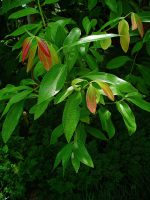 Also known a Ceylon cinnamon tree, this small evergreen tree is native to Sri Lanka and a member of the Laural family, Lauraceae, that also includes avocado and cassia. The tree grows up to 50′ tall and has spreading branches with smooth, ash-colored bark. Young leaves are reddish bronze in color while mature leaves are green, ovate to oblong, heavily veined, and up to 9″ long. Panicles of greenish flowers with a distinct odor appear from spring to summer and give way to a purple drupe with a single seed. Plants are grown commercially for the inner bark that is used to make the spice cinnamon for cooking as well as herbal medicine. The trees do well in pots and can be grown indoor during cold weather and moved outside during the summer. Warm moist climates are most suitable. The genus name, Cinnamomum, is derived from the Maylasian/Indonesian word kayu manis meaning sweet wood. The specific epithet, verum, is the Latin word for true, suggesting that this species is superior to some other plants that have a similar taste and smell.
Also known a Ceylon cinnamon tree, this small evergreen tree is native to Sri Lanka and a member of the Laural family, Lauraceae, that also includes avocado and cassia. The tree grows up to 50′ tall and has spreading branches with smooth, ash-colored bark. Young leaves are reddish bronze in color while mature leaves are green, ovate to oblong, heavily veined, and up to 9″ long. Panicles of greenish flowers with a distinct odor appear from spring to summer and give way to a purple drupe with a single seed. Plants are grown commercially for the inner bark that is used to make the spice cinnamon for cooking as well as herbal medicine. The trees do well in pots and can be grown indoor during cold weather and moved outside during the summer. Warm moist climates are most suitable. The genus name, Cinnamomum, is derived from the Maylasian/Indonesian word kayu manis meaning sweet wood. The specific epithet, verum, is the Latin word for true, suggesting that this species is superior to some other plants that have a similar taste and smell.
Type: Evergreen tree
Outstanding Feature: Inner bark
Form:Rounded
Growth Rate: Slow
Bloom: Panicles of greenish flowers from spring to summer
Size: 30-50′ H x 35′ W
Light: Full sun to partial sun
Soil: Fertile, moist, well-drained, acidic to neutral
Hardiness: Zones 10-12
Care:Keep moist; avoid prolonged drought
Pests and Diseases: Cinnamon is susceptible to damage by many pests and diseases including jumping plant louse, mite, common mime, blue bottle, leaf and shoot Webber, hairy caterpillar, wood boring mothe, fruit borer, leaf miner, sorolopha semiculta; leaf spot, die back, seedling blight, grey eaf spots, black sooty mold, algal leaf spots, stripe canker, pink disease, brown root rot.
Propagation: Seed, semi-ripe cuttings, division
Photo Credit: Wikipedia